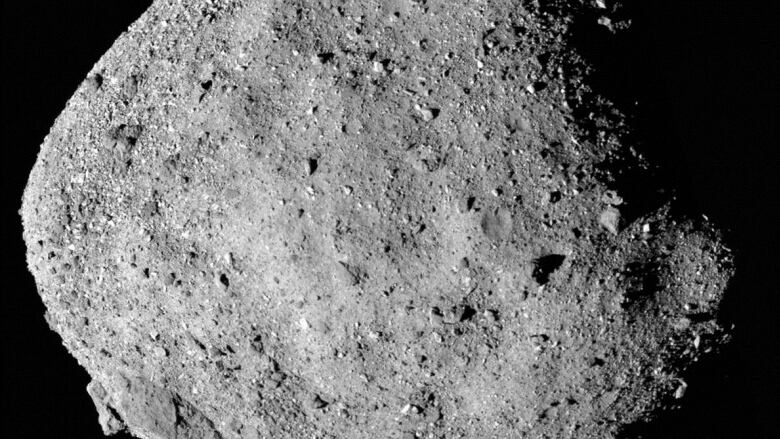Crucial part of OSIRIS-REx's mission to collect asteroid sample made possible by Canadian instrument
NASA spacecraft has been in orbit around asteroid Bennu since 2018

On Tuesday, NASA's OSIRIS-RExmissionwill make historyas it attempts its first collection of material from an asteroid to be returned to Earth in 2023.
The spacecraft which arrived at the asteroid Bennu in 2018 will conduct atouch-and-go manoeuvre, also referred to as TAG. This crucial part of the missionwas made possible in part by Canadian technology, specificallythe Canadian Space Agency's OSIRIS-REx Laser Altimeter (OLA), which mapped the surface of Bennu in 3D.The asteroidlies roughly 332 million kilometres from Earth.
That mapping turned out to be extremely important. Scientists and engineers had anticipated the asteroid to be mostly smooth and dusty. But that wasn't the case.
"When we arrived we realized very, very quickly that there wasn't a single area on the entire asteroid that was 50 metres across that had no obstacles," said Tim Haltigin, senior mission scientist of Planetary Exploration at the Canadian Space Agency.
"And so we really had to rethink our planning of how we were going to select a sample siteand where we could safely deliver the spacecraft.And I think that's one of the reasons why theOLA instrument became even more crucial in terms of understanding the roughness, the topography, the slopes of the surfaces to really be able to pick a site where we knew that we could get the spacecraft down safely to collect a sample."
Mike Daly, OLA'Slead instrument scientist, said that he's very pleased with the amount of detail and precision it was able to provide.
"When I was thinking about what this instrument had to do and what it was how it would perform we had a much smoother Bennu, a much more boring Bennu in mind," said Daly, who is also a professor at York University's Lassonde School of Engineering in Toronto. "So when you see the detail that came out of this instrument, it's just unbelievable. It blew us all away, honestly.
"So, we'repretty proud of it."
WATCH|A rendered rotation movie of Bennu taken by the Canadian OLA instrument:
Daly has been working on the instrument for 12 years, while Haltigin has been working on it for seven years. Both men saidthat it's become a part of their lives.
"It's a little bit bittersweet," Daly said.
The great part about the sample-return mission is that, because Canada is a partner, it getssome of the material. It's something that Haltigin is extremely excited about.
"It's going to be owned by Canada, and so we're going to be able to make these samples available for generations and generations of Canadian scientists," he said. "So, we're basicallyenabling the next 50 to 100 years of discoveries based on these samples."
'Kissing the surface'
Rather than landing on the asteroid'ssurface, a set of manoeuvres will be conducted in order to collect material.
"Due to the low gravity, we can't actually land on the surface of Bennu. So we'll only be kissing the surface with a short touch and go, measured in just seconds," Beth Buck, OSIRIS-REx mission operations program manager for Lockheed Martin Space,said in a teleconference on Monday.
Compressed nitrogen gas will be pumped out onto the surface, which will stir up particles that will then be collected by a sampler.
The collection will take place at 6:12 p.m.ET and will be broadcast live on NASA TV. It canalso be watchedon CBC.ca beginning at 5 p.m.

It will take roughly 18.2 minutes for a signal to be received from the spacecraft. However, while NASA expects to get confirmation that the manoeuvretook place on Tuesday, itwon't know for certain until Wednesday if material was successfully collected.
TheOSIRIS-RExspacecraft has gone through a couple of rehearsals of the manoeuvre,one in April and another in August, so NASAhopesitwill be successful. However, itdoes have two more opportunities to collect material should this be unsuccessful.
It's not the first time material has been collected from an asteroid. The Japanese Space Agency, JAXA, is currently awaiting the return of the Hayabusa2 spacecraft with a sample from the asteroid Ryugu, scheduled to return in December.
Think of asteroids astime capsules
OSIRIS-REx launched in 2016 and arrived at Bennuin December 2018. Since then, it has been in orbit around the asteroid.
Bennuis about 492 metres in diameter and orbits the sun once every 1.2 years. It wasn't discovered until 1999 and wasn't given an official name chosen by a Grade 3 student from North Carolina until 2012 (the name refers to an Egyptian mythological bird).
The asteroid is believed to be roughly 4.5 billion years old, as old as the solar system itself. And that's key: astronomers hope that Bennu can shed some light on how the solar system formedand how ultimately life may have arisen on Earth.
"Collecting a sample from an asteroid is the equivalent of going back in time by over four billion years to understand what the early solar system was made of," said Haltigin."So, you can think of asteroids almost as time capsules that have preserved the materials from the very formation of the solar system."
There is also a very small chance that Bennu will collide with Earth. But there's no need to panic: there's only a onein 2,700 chance that will happen between the years 2175 and 2199, according to NASA.
For now, scientists and engineers will be on the edge of their seats, awaiting confirmation that the mission was successful. And the asteroid is bound to have some surprises.
"What excites me the most, I'll be perfectly honest, is we're going to find out something that nobody expected, and I don't know exactly what that is," Haltigin said. "But I do know that we are going to be shocked and surprised and amazed once we figure it out."













_(720p).jpg)


 OFFICIAL HD MUSIC VIDEO.jpg)
.jpg)



























































































